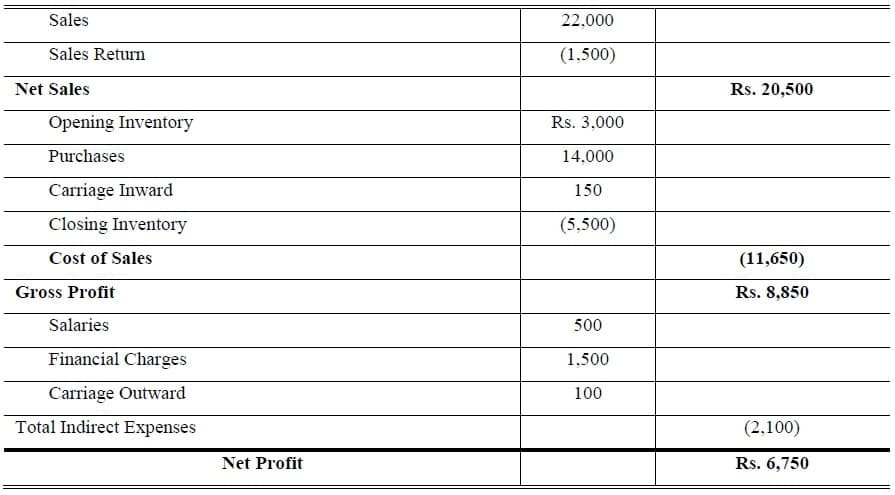COST ACCOUNTING PROBLEMS AND SOLUTIONS
1. Ascertain Cost of Goods Sold from the following figures:
Purchases Rs. 5,000; Opening Stock Rs. 15,000; Closing Stock Rs.7,000.
Solution:

2. Ascertain Gross Profit / Loss form the following figures:
Closing Stock Rs. 1,500; Sales Rs. 14,000; Opening Inventory Rs. 12,000; Net Purchases Rs. 7,500; Rs. Return Inward Rs. 2,500.
Solution:

3. Ascertain Purchases from the following figures:
Cost of Sales Rs. 90,000; Ending Inventory Rs. 7,000; Beginning Inventory Rs. 15,000.
Solution:

4.From the following information extract Gross Profit and Net Profit:
Opening Inventory Rs. Rs. 3,000; Purchases Rs. 14,000; Sales Rs. 22,000; Closing Inventory Rs. 5,500; Sales Return Rs. 1,500; Salaries Rs. 500; Financial Charges Rs. 1,500; Carriage Inward Rs. 150; Salaries Outstanding Rs. 400 ; Carriage Outward Rs. 100.
Solution:

Use the following information of Fatima Malik and Co.
A company just starting business made the following four inventory purchases in June 2016:
June 1 150 units Rs. 6.60/unit cost Rs. 990
June 10 200 units Rs. 6.30/unit cost 1,260
June 15 200 units Rs. 5.85/unit cost 1,170
June 28 150 units Rs. 5.20/unit cost 780
Rs. 4,200
A physical count of merchandise inventory on June 30 reveals that there are 250 units on hand.
Requirement (a): Using the periodic LIFO inventory method, the value of the ending inventory on June 30 is?
Solution:

Requirement (b): Using the periodic FIFO inventory method, the amount allocated to cost of goods sold for June is?
Solution:

From the following calculate (i) Re-ordering Level and (ii) Minimum Level
Minimum usage 100 units per week Normal usage 200 units per week
Maximum usage 300 units per week Re-order period 4 to 6 weeks
Solution:
(i) Re-ordering Level
Re-ordering level= Maximum consumption * Lead Time [maximum]
Re-ordering level= 300 * 6
Re-ordering level= 1,800 Units per week
(ii) Minimum Level
Minimum level= Reorder level – (Average consumption x lead time [Average])
Minimum level= 1,800 – (200 x 5)
Minimum level= 1,000 Units per we
Problem # 2:
Calculate Ordering Level, Minimum Level and Maximum Level from the following data:
Re-order quantity 1,500 units Re-order period 4 to 6 weeks
Maximum consumption 400 units per week Average consumption 300 units per week
Minimum consumption 250 units per week
Solution:
(i) Ordering Level
Ordering level= Maximum consumption * Lead Time [maximum]
Ordering level= 400 * 6
Ordering level= 2,400 Units per week
(ii) Minimum Level
Minimum level= Reorder level – (Average consumption x lead time [Average])
Minimum level= 2,400 – (300 x 5)
Minimum level= 900 Units per week
(iii) Maximum Level
Maximum stock level= Reorder level – (Min consumption * Lead time [minimum]) + EOQ
Maximum stock level= 900 – (250 * 4) + 1,500
Maximum stock level= 2,400 – (1,000) + 1,500
Maximum stock level= 2,900 Units per week
Problem # 3:
The following information is available in respect of component DP 5:
Maximum stock level 8,400 units
Budgeted consumption- maximum 1,500 units per month
Budgeted consumption- minimum 800 units per month
Estimated delivery period Maximum 4 months and minimum 2 months
You are required to calculate Re-order level
Solution:
Ordering Level
Ordering level= Maximum consumption * Lead Time [maximum]
Ordering level= 1,500 * 4
Ordering level= 6,000 Units per week
Problem # 4:
From the following date for the last twelve months, compute the Average Stock Level for a component.
Maximum usage in a month 300 units Minimum usage in a month 200 units
Average usage in a month 225 units Re-ordering quantity 750 units
Time lag procurement of material Maximum 6 months and Minimum 2 months
Solution:
Average Stock Level
Average Stock Level = Minimum Stock Level + ½ of EOQ
Minimum level= Reorder level – (Average consumption x lead time [Average])
Re-ordering level= Maximum consumption * Lead Time [maximum]
Re-ordering level= Maximum consumption * Lead Time [maximum]
Re-ordering level= 300 * 6
Re-ordering level= 1,800 Units per month
Minimum level= Reorder level – (Average consumption x lead time [Average])
Minimum level= 1,800 – (225 x 4)
Minimum level= 900 Units per month
Average Stock Level = Minimum Stock Level + ½ of EOQ
Average Stock Level = 900 + ½ (750)
Average Stock Level = 1,275 Units per month
Problem # 5:
Find out Minimum Stock Level, Maximum Stock Level and Ordering Level from the following particulars:
Minimum consumption 100 units per day Maximum consumption 175 units per day
Normal consumption 125 units per day Re-order quantity 1,500 units
Minimum period for receiving goods 7 days Maximum period for receiving goods 15 days
Normal period for receiving goods 10 days
Solution:
(i) Ordering Level
Ordering level= Maximum consumption * Lead Time [maximum]
Ordering level= 175 * 15
Ordering level= 2,625 Units per week
(ii) Minimum Level
Minimum level= Reorder level – (Average consumption x lead time [Average])
Minimum level= 2,625 – (125 x 10)
Minimum level= 1,375 Units per week
(iii) Maximum Level
Maximum stock level= Reorder level – (Min consumption * Lead time [minimum]) + EOQ
Maximum stock level= 2,625 – (100 * 7) + 1,500
Maximum stock level= 3,425 Units per week

Comments
Post a Comment